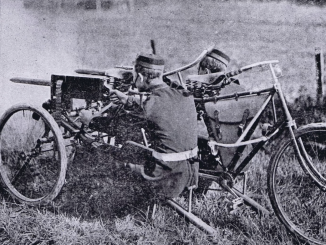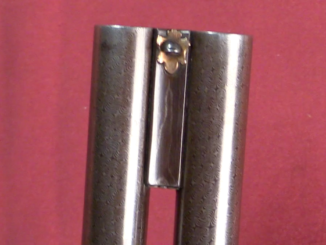The Patchett Machine Carbine Mk I is the predecessor to the Sterling SMG. It was developed by George William Patchett, who was an employee of the Sterling company. At the beginning of the war, Sterling was making Lanchester SMGs, and Patchett began in 1942 working on a new design that was intended to be simpler, cheaper, and lighter than the Lanchester. He used the receiver tube dimensions from the Sten and the magazine well and barrel shroud form the Lanchester. His first prototypes were ready in 1943, but it wasn’t until early 1944 that the British government actually issued a requirement for a new submachine gun to replace the Stens in service.
The initial Patchett guns worked very well in early 1944 testing, which continued into 1945. It ultimately came out the winner of the trials, but they didn’t conclude until World War Two was over – and nothing was adopted because of the much-reduced need for small arms. Patchett continued to work on the gun, and by the 1953 he was able to win adoption of it in the later Sterling form – which is a story for a separate video.
The Patchett was not used in any significant quantity in World War Two. At most, a few of them may have been taken on the parachute drops on Arnhem – there are specifically three trials guns which appear referenced in British documents before Arnhem, but are never mentioned afterwards (numbers 67, 70, and 72). Were they taken into the field? We really don’t know.
Many thanks to the Royal Museum of the Armed Forces and Military History in Brussels for access to this very rare piece! Check them out here:
https://www.klm-mra.be/en/




Got to shoot a Sterling when I was visiting Boca Chica in south Texas. Very smooth, very easy to keep on target, even w/ my very limited experience w/ full auto.
“(…)He used(…)Sten(…)Lanchester(…)”
Wait…, does not that made presented weapon so-called frankengun?
“(…)George William Patchett(…)”
What was his interaction (if any) with George Lanchester who was developing weapon known as Lanchester Model 1 https://guns.fandom.com/wiki/Lanchester_Model_1 which also was lighter derivative of Lanchester Machine Carbine?
“(…)Armhem(…)Anrhem(…)”
Wait, which one is currently accepted name in U.S. historiography for OPERATION MARKET GARDEN?
Daweo, how about simply using the Dutch name of the city: Arnhem.
The Germans on the other side of the border call it Arnheim.
OFF-TOPIC so ignore if you wish
Recently REAPR-338 was unveiled https://modernfirearms.net/en/machineguns/u-s-a-machineguns/reapr-338-2/ despite looking like machine gun and consuming belts, it is supposedly Recoil Enhanced Automatic Precision Rifle, 338 caliber, but can it be? Would not rifling wear of firing full-auto decrease precision?
It is also …fitted with a quick-removable barrel that also makes possible various caliber conversion, which would, obviously, also require a bolt group and feed unit changes. The one conversion which was already mentioned is to fire a less powerful and less expensive 7.62x51mm NATO ammunition, how much time such conversion requires? Was such feature present in any earlier machine gun?
Recoil enhanced; in English, suggests Mg42 type action, which looking at it… .338 Looks skinny, mind you tech changes; stock fold does it, a miracle.
Recoil Enhanced Automatic Precision Rifle, 338 caliber, obviously meaning that this powerful machine gun can be used by a single person in a tactical role similar to the “automatic rifle” really… Well the miracle of google translate eh. I mean I speak English, and I did not read it as such.
Anyway looks “Skinny” that perhaps it is about 3 shot bursts or such as oppose a gpmg. Unless that is just me, titianum or something is it
Got to love the Stering.
Aye might be it sort of belt loads a form of Breda mag…
Not sure but it mentions a “Funny mag feed thing” looks too slim for a gpmg, yet to google it.
Norma mag; well I doubt that will be replacing .50 Bmg per se.
Googled it, well very modern eh. “Single person in a tactical role similar to the automatic rifle” quite… Well thats me told and my Mg42’s been out technolgied eh – Bollocks, and I don’t mean to the Mg42’s.
Anyway Daweo, I reckon it would cost that much, that the manual says “Buy a new barrel” via the app, qr code on the side of the gun. And the Manual faq, question two; states… Next question. Then a blank page.
I’ve recently watched videos on it. It’s clearly a machine gun, not a rifle. It weighs 26 pounds. It appears to be a cheaper alternative to the SIG MG338, avoiding its complexity at the cost of 8 pounds more weight. Given that the Army seems to be limiting its purchases of the MG338, Ohio Ordnance might have the right idea.
Mind you, depends how accurate said 3 shot’ish bursts are from prone. I mean if you could actually hit the fecker, with 1 out 3 even. Instead of scaring them to death with 1,000 and then hitting them with the spike on your pickelhaube, well that is progress… I wouldn’t like folk to think I am some sort of philistine, potentially forcing people into slaughtering the enemy with a Mg42… And indeed a pointy hat, which would have won WW1 for the central powers…
Flat dark earth mind, seems aimed at essentially… Techonlogical… Less advanced sorts, such as in Yemen; who doubtless believe in a form of Santa as adults etc… Which is not fair on them, or us given we may actually be getting nerve gassed etc by Russia.
Fear your own leaders. It is the current White House resident who keeps threatening his own people with F-16’s
Fundamentally, the Patchett/Sterling is a Lanchester redesigned to make maximum use of stampings during manufacture.
Which is another way of saying it’s a stamped-steel Mp.28 “clone”, since the Lanchester was an Mp.28 copy to begin with.
All it really has in common with the Sten gun (any version), other than being a 9 x 19mm “machine carbine”, is that its receiver is the same size of Schedule 80 seamless steel tubing as used in the Sten. And that was adopted by Shepherd and Turpin in 1940 because it was available “off the rack”. The cooling holes in the forward part around the barrel were basically copied from the Beretta Mo.38.
The most original feature of the Patchett/Sterling is its pistol grip. It was apparently the first SMG design anywhere to have one at its approximate point of balance. The under-folding stock was largely copied from the German MP38/40, except it has a stronger setup.
The Patchett/Sterling is one of the better thought-out second generation SMGs, but there really isn’t very much about it that can be called “original”.
clear ether
eon
And the roller mag thing, on the Sterling; which, previously… I seem to remember you saying as above “But the mag was great.” Eon.
Yes, that was a smart idea. It’s probably the main reason that even today the Sterling is one of the more feed-reliable SMGs around.
Note that the original Patchett used the Sten magazine, but its own magazine developed around 1946-47 was apparently mostly copied from the 30-round PPSh-41 magazine.
The Russians figured out that tapered cartridge cases fed more reliably from a curved magazine before almost anybody else except the Japanese; see Type 1 Experimental SMG in 8 x 22mm Nambu (c. 1935):
https://www.imfdb.org/wiki/Nambu_Experimental_Submachine_Gun
In many ways, it was almost two decades ahead of its time.
cheers
eon
“(…)30-round PPSh-41 magazine(…)”
Was it this? I am only aware of 71-round drum and 35-round banana magazine. Please provide drawing or other illustration of said 30-round magazine.
To my understanding Patchett magazine is double-stack-double-exit, which make it more similar to PPS rather than PPSh, see https://commons.wikimedia.org/wiki/File:PPSh-PPS-mags.jpg?uselang=ru
“(…)except the Japanese(…)”
Finnish 7,65 mm Suomi M/26 used curved magazine
http://www.jaegerplatoon.net/MACHINEPISTOLS1.htm
direct image link http://www.jaegerplatoon.net/Suomi26_3.jpg
though it consumes 7,65×21 mm Parabellum cartridge (then default pistol cartridge in Finland) which is bottleneck rather than tapered.
I wouldnt agree at all on stampings claim, actually Sterling is an regression (in post ww2 industrial means) as it uses seamless tube for receiver, even sten mk.3 has stamped,wrapped receiver
their biggest innovation was the way it was all assembled with silver soldering, as opposed to individually welding stuff on rec. tube.
Good example of all stamping is Grease Gun, Franchi Lf 57 or Walther mpl.
There’s at least one picture showing a Patchett in use in operation ”Market Garden” Picture was probably made somewhere around Arnhem (Veluwe, Oosterbeek?)
https://www.tumblr.com/augfc/173768094555/the-patchett-gun-in-arnhem-in-1944-there-were
The picture is not very clear, but the tubular receiver is clearly recognizable.
I have fired a Sterling SMG! As a part of my training as a Marksman / Coach. And the Sten, and the OWEN Gun of course. My favourite SMGun was the Australian F1. Much more ergonomic than the OWEN gun. (The OWeN gun is worth lokking up on-line). It helped us a LOT in New Guinea and the islands furher north.
The F1 was Less heavy and yet still nore controllable !? under full auto. And, accurate enough for single shots, out to 100 metres. Much easier to fire as an issue weapon than the OWEN Gun ever was. And it came with a cleaning kit and a loader for the Magazine. You could put the three 10rd clips in quite quickly, once you learned to leeve the cliploader on top of the RH ammo pouch! Different for a left-hander – but just as quick! NOt as iconic as the Owen Gun IS in our history!
“(…)F1 was Less heavy and yet still nore controllable(…)”
My cursory search revealed that F1 has smaller Rate-of-Fire (600 vs 700), F1 has also much different furniture shape, so point of contact with shoulder is much closer to barrel axis, which should lessen muzzle climb.
Ive read a comment, thats completely opposite in valueing F1 to Owen ! Now, who to trust…
“(…)opposite(…)”
But then this would need explanation how they managed to get Cold War era weapon inferior to WW2 weapon.
Its probably I suppose more of an end user quirk that prefered the older gun. It is half kg lighter though, but thats not drastic, but some say every pound counts when carrying and marching for a long time.
I’ve had an unusual PATCHETT 9mm smg. No markings or s/n on the mag. housing. But…it is stamped “8” on the inside of the receiver cap…like s/n 47 Patchett. The barrel is retained differently and has a small flash hider on it. I has a bolt similar to a Sten….with a similar recoil spring. The receiver is slightly larger in diameter than the Patchetts and Sterlings. Sterling, Sten and Lanchester magazines do not fit in the magazine housing. The pistol grip is a brown phenolic, held on with two screws on each side. No flutes on the bolt. It has eleven things similar to the Sterling and only four things similar to the internet published Patchetts. Have a blessed day. David
E:\Gun\MG’s and canon\Patchett smg, no s-n\My Pachett, experimental, Pre-production\IMG_3314.JPEG